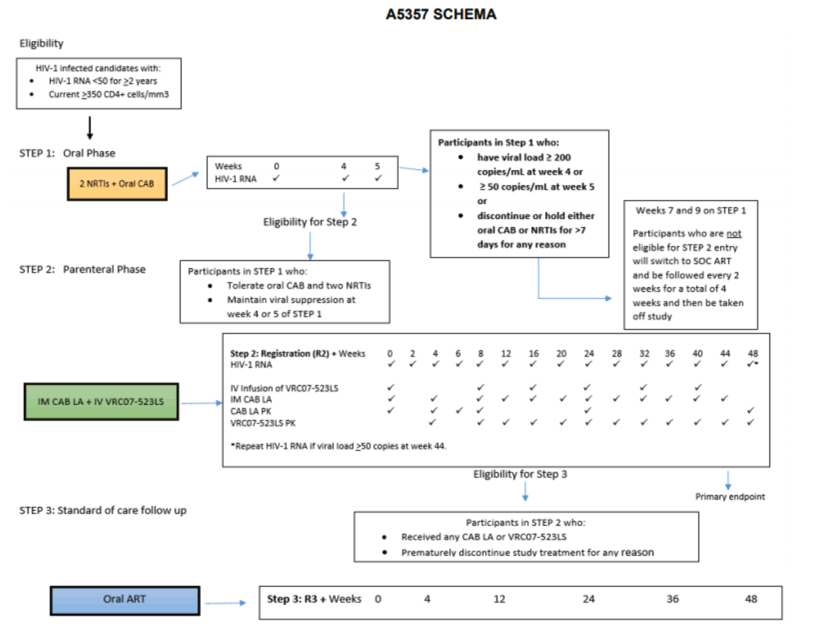| |
A Study of Long-Acting Cabotegravir Plus VRC-HIVMAB075-00-AB (VRC07-523LS) to Maintain Viral Suppression in Adults Living with HIV-1
A Multicenter Trial of the AIDS Clinical Trials Group (ACTG) - A5357
|
| |
| |
Sponsored by:
National Institute of Allergy
and Infectious Diseases
In Collaboration with:
Vaccine Research Center, National Institutes of Health
Industry Support Provided by:
Monogram Biosciences, Inc.
ViiV Healthcare
One of the most exciting areas of research in ART is long acting therapies; another is novel therapeutics; A5357 combines both. As a vanguard study of long-acting bNAb + LA ARV two-agent construct, A5357 opens up a totally new paradigm. The 5357 study is a pilot, with very limited goals- 1) is this safe? , 2) is there promise here?. We hypothesize that this new LA construct will maintain HIV suppression, hence may be suitable for further investigations. As bNAbs improve in antiviral breadth and potency as well as PK/effector functions, A5357 will be a critical foundation to build other studies upon. A future with Q12 week ART dosing option may not be far away. This would be good for PWH.
Phase II, single arm, open-label switch study to assess the safety, tolerability, pharmacokinetics, and antiviral activity of long-acting cabotegravir (CAB LA) plus the broadly neutralizing monoclonal antibody, VRC-HIVMAB075-00-AB (VRC07-523LS) in adults living with HIV-1 with suppressed plasma viremia. The hypothesis is that the combination of long-acting cabotegravir (CAB LA) and VRC-HIVMAB075-00-AB (VRC07-523LS) is safe and will prevent viral rebound (confirmed HIV-1 RNA ≥200 copies/mL) in individuals who have achieved suppression with conventional antiretroviral therapy (ART). Study will also evaluate evidence of anti-idiotype antibodies against VRC07-523LS in samples collected from representative time points throughout the study; compare genotypic and phenotypic characteristics (viral clonality, neutralization resistance, and integrase resistance) from baseline samples (entry or pre-ART) and failure HIV-1 isolates in individuals who experience viral rebound while receiving the combination of VRC07-523LS and CAB LA; genotypic testing will be performed for protease/reverse transcriptase (PR/RT) and integrase resistance. In addition, samples from the failure confirmation visit and pre-ART or entry (if available) will be tested for viral clonality, integrase resistance, and VRC07-523LS neutralization resistance.
During Step 1, participants tolerating oral CAB plus their current two NRTIs with HIV-1 RNA <50 copies/mL at week 4, or HIV-1 RNA of 50-199 copies/mL at week 4 followed by HIV-1 RNA <50 copies/mL at week 5, will register to Step 2 and receive CAB LA every 4 weeks through week R2+44 plus VRC07-523LS every 8 weeks through week R2+40. At entry into Step 2, participants will stop their oral CAB and NRTIs and will receive VRC07-523LS infusion (40 mg/kg) plus CAB LA intramuscular (IM) injection (600 mg). Post entry in Step 2, participants will receive CAB LA IM injection (400 mg) every 4 weeks through week R2+44 plus VRC07-523LS infusion (40 mg/kg) every 8 weeks through week R2+40.

|
|
| |
| |
|
|
|